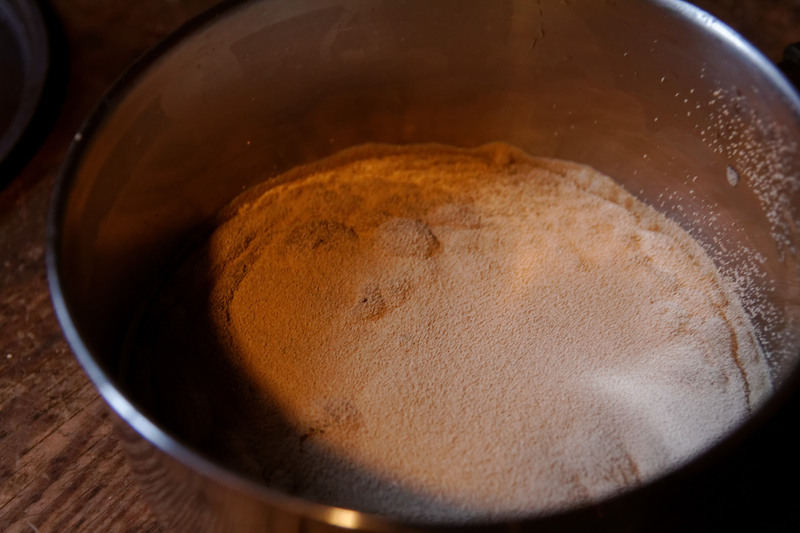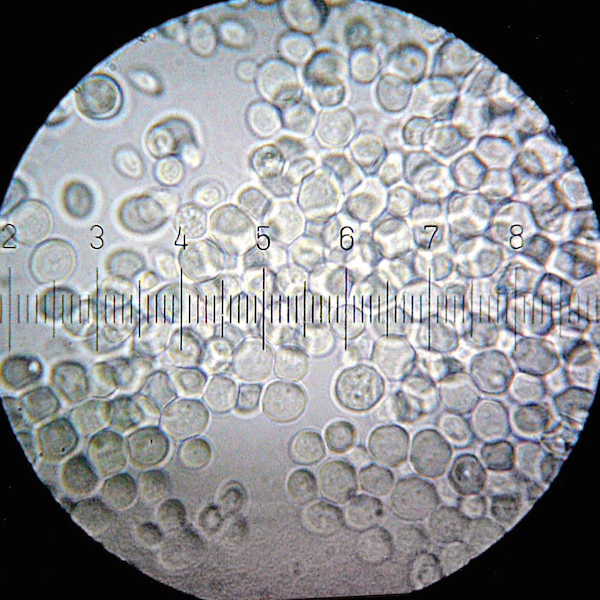The Saccharomyces family

Yeast starter. Kaupanger, Norway |
The series on yeast taxonomy now ends with a post on the various species in the Saccharomyces family. If you don't know what a genus is, or what, exactly, Saccharomyces is, read the first post in the series. The family contains two members most people know very well, and then a whole series of lesser-known members.
Anyone reading the scientific literature on this will soon run into the phrase "Saccharomyces sensu stricto complex," which really just means "Saccharomyces genus in the strict sense." For much of the 20th century, Saccharomyces was interpreted much more broadly, and used to include lots of species that later research has shown are not very closely related after all. So the old Saccharomyces genus is usually referred to as "Saccharomyces sensu lato" (broad sense).
One of the things that distinguishes Saccharomyces yeasts (sensu stricto) from their nearest relatives (sensu lato) is that very roughly 100 million years ago something happened that caused the entire genome of the yeast to be duplicated. That is, suddenly the yeast had two copies of every gene. The copies then drifted apart, but enough of this remains that scientists could show what happened.
The best-known species in the family is clearly Saccharomyces cerevisiae, which is usually known as beer yeast or ale yeast. The name literally means "sugar-fungus of beer". This yeast is used in beer (though not lager), wine, cider, sake, palm wine, bread, and so on. However, it's mostly associated with beer because it was beer researchers who did most of the early work on it. Some people like to call beer brewed with this species of yeast ale (as opposed to lager).
The other well-known species is Saccharomyces pastorianus, named after Louis Pasteur. The unusual thing about this species is that it is cold-tolerant, in the sense that it can ferment as cold as 5 degrees centigrade. At temperatures this low S. cerevisiae goes into hibernation and stops fermenting, but lager yeast will happily keep on working. So this is what distinguishes bottom-fermented beer: the use of this yeast species, and lower fermentation temperatures.
These are generally the only Saccharomyces yeasts used in beer (even lambic). However, S. pastorianus didn't evolve on its own, but is actually a hybrid formed from several members of the family. That means the rest of the family is relevant for us, after all. A useful way to look at it is to see the "cladogram", that is, a tree showing which species are the most (and least) genetically similar.

Saccharomyces cladogram |
There are two ways to read this diagram. One is to go from left to right. The line that extends to the left represents the common ancestor of all of these species. The lineage then splits in two, one group containing ale yeast and most of the species, and the other containing two oddballs at the bottom.
The other way to read it is to start with normal ale yeast on top, then, going down, the various Saccharomyces species, starting with the one most closely related to S. cerevisiae, and getting less and less related as you go down. The two at the bottom are most similar to each other, and not that similar to the others, since they branched off the earliest.
Some people have confused the bottom species, S. uvarum, with lager yeast. There has been considerable confusion around this species over the years, and for a while it was not considered a species at all. All this has been cleared up in the last few years and it's now clear that S. uvarum and S. pastorianus are definitely two different species of yeast. S. uvarum is widely used in wine fermentation, and also in cider. Many sources claim it's also used in beer, but I suspect this is a holdover from the period when it was thought to be the same as lager yeast. I don't know of anyone using S. uvarum in beer.
The two yeasts at the top of the diagram prefer relatively high temperatures, whereas S. kudriavzevii prefers the lowest temperatures. The two at the bottom also like cold temperatures. And, speaking of cold temperatures, why is there no S. pastorianus in this diagram? The answer is that the diagram shows the evolutionary tree, and S. pastorianus doesn't fit there, because it's a hybrid that was formed from two of these species. It didn't branch off, it was instead created by two branches fusing.

Saccharomyces cerevisiae. Bob Blaylock, Wikimedia Commons. |
The two species that gave birth to lager yeast are S. cerevisiae and S. eubayanus, which is one of the cold-tolerant species. It has been known for decades that lager yeast was a hybrid of ale yeast and some other species, but which species was not known. Then S. eubayanus was discovered in 2011 in Patagonia, and was found to match 99.56% of the non-ale yeast part of the lager yeast genome. Initially there was some confusion as to how it managed to travel from Patagonia to Bavaria to work in lager brewing, when lager brewing began before any European visited Patagonia.
However, in 2014 S. eubayanus was found on the Tibetan plateau in Tibet and the western Chinese provinces of Qinghai, Sichuan and Shaanxi. The yeasts found here turned out to match the S. pastorianus genome even more closely, so it seems likely that the ancestors of lager yeast came from this area. Given that the Silk Road passed through this area that provides an possible explanation for how the yeast came to Europe. When the hybrid was formed, and where, remains unknown.
Very likely, what happened was that the early lager brewers were brewing with mixed yeast cultures. That's what kveik is, and these yeast cultures will have been treated the same way. Probably the brewers began by fermenting at relatively, but not very, cold temperatures. This will have given cold-tolerant yeasts an advantage. At some point, already-formed S. pastorianus got into the fermentation, or it was formed in a brewery. At that point, evolutionary pressure towards tolerating cold would have caused it to out-compete the other yeasts, and lager brewing with S. pastorianus began.
Interestingly, S. pastorianus is divided into two groups, which may have arisen separately. One is the Saaz group, which was used in the Czech Republic and by Carlsberg. The other is the Frohberg group, which was used by other Danish breweries and also in the Netherlands. (What did the areas not mentioned here use? The literature doesn't say.) Frohberg has lost most of the S. eubayanus r-DNA, while Saaz has lost most of the ale yeast genome, so these two groups are quite different. Saaz seems to produce less higher alcohols and esters during fermentation, which is also interesting.
The reason ale yeast doesn't have a simple breakdown like this is that it's a much older species, with a much more complicated history. Researchers are working to try to piece together that history, however. One paper built a cladogram of 651 Saccharomyces cerevisiae strains, and found a huge wine/cider group, with a small Italian/Sicilian bread group in the middle of it. Other groups were various distillery groups, Nigerian palm wine, bread (again), fermented milk (France and Morocoo), sake (obviously Japan), and, of course, ale.
That the yeasts should cluster like this is interesting, and the researchers thought this might shed light on human history as well, but very likely more work is needed before any firm conclusions can be drawn. There's also work on the way on making a family tree of beer yeast, which is surely going to be interesting. So very likely there will be many new results coming over the next few years.
Sources
Saccharomyces diversity and evolution: a budding model genus. Chris Todd Hittinger. Trends in Genetics, 29 (2013) 309-317. doi:10.1016/j.tig.2013.01.002
The ecology and evolution of non-domesticated Saccharomyces species, Boynton, P. J., & Greig, D. Yeast 2014, Wiley. http://doi.org/10.1002/yea.3040
Evidence for a Far East Asian origin of lager beer yeast, Jian Bing et al, Current Biology, vol 24 issue 10, 2014. http://dx.doi.org/10.1016/j.cub.2014.04.031
Bread, beer and wine: Saccharomyces cerevisiae diversity reflects human history, Legras et al, Molecular Ecology (2007) 16, 2091-2102, doi: 10.1111/j.1365-294X.2007.03266.x.
Similar posts
Muri: A Mystery Solved
I wrote about the Muri mystery and how I didn't think we'd ever solve it, but yesterday I got an email out of the blue
Read | 2019-09-12 08:51
The Yeast Family Tree Grows
A few years ago I wrote about the groundbreaking study (Gallone et al 2016) that for the first time gave us an idea of how the different types of brewers yeast are related to each other
Read | 2021-10-26 10:39
What is it that ferments lambic?
As everyone knows, lambic is fermented by "wild yeast and bacteria"
Read | 2015-02-20 11:00
Comments
Ed - 2015-10-17 08:37:11
I believe it's the Carlsberg strain that is by far the most widely used but I can't find a reference at the moment.
John Boblem - 2015-10-17 11:20:35
The first picture in your post kind of killed it for me. It's a picture of yeast being rehydrated, and you call it a starter. Doesn't bode well for the rest of the article.
Lars Marius - 2015-10-17 12:48:32
@Ed: Any reference would be highly welcome.
@John: Yes, the yeast is being rehydrated, but it's being rehydrated in wort. So it really is a starter. You can scoff at that technique, but it's how farmhouse brewers typically do it, and that photo was taken in a traditional brewhouse.
pricelessbrewing - 2015-10-17 13:10:38
@John Don't be so quick to jump to conclusions, Lars knows his stuff.
Ed - 2015-10-18 06:16:56
Ooops, looks like I had it the wrong way round:
COMPARATIVE PHYSIOLOGY AND FERMENTATION PERFORMANCE OF SAAZ AND FROHBERG LAGER YEAST STRAINS AND THE PARENTAL SPECIES SACCHAROMYCES EUBAYANUS.
Gibson, B.R., Vidgren, V. and Storgards, E., Proc. Am. Soc. Brew. Chem., Tucson, 2013 (abstract published online - PowerPoint presentation available).
Efficient fermentation is dependent on optimal process conditions for a given yeast strain or, alternatively, selection of a suitable yeast strain for particular process conditions. Understanding the requirements and capabilities of individual strains, therefore, is key to ensuring efficiency. In recent years, genomic studies have identified 2 distinct genetic groups (Saaz and Frohberg) within the Saccharomyces pastorianus lager yeast group and, furthermore, have identified the parental species (S. eubayanus × S. cerevisiae) of this hybrid. However, it is not known how the 2 hybrid groups differ physiologically, if at all. The fermentative capability of S. eubayanus has likewise never been studied. Here, 60 lager strains were screened to determine which hybrid group they belong to and selected strains (3 Saaz and 3 Frohberg) were characterised to determine salient characteristics of each group. Two ale strains and the type strain of S. eubayanus were included for comparative purposes. Saaz strains, which are most closely related to the cryotolerant S. eubayanus parent, were found to be less sensitive to cold (10 degrees C) than Frohberg strains. In 15 degrees P all-malt wort fermentations at relatively high temperature (22 degrees C) the Frohberg strains showed greater growth and superior fermentation performance (80% apparent attenuation in 3 to 4 days) compared with all other strains (including ale strains). Cropped Frohberg yeast also had the highest viability values (> 93%). The fermentation performance of S. eubayanus was poor at 22 degrees C (with apparent attenuation of only 33% reached after 6 days) and cell viability was reduced to 75% by the end of the fermentation. The cryotolerant Saaz lager yeasts grew relatively well during low temperature fermentations (10 degrees C), but this did not translate to greater fermentation performance, possibly due to adaptation of these strains to lower wort gravities. Performance of S. eubayanus at 10 degrees C was equal or greater to that of the Saaz strains and growth was greatest in this strain compared with all others. Saaz strain fermentations were characterised by a relatively low production (2- to 6-fold lower than Frohberg strains) of the flavour compounds methyl butanol, ethyl acetate and isoamyl acetate, irrespective of temperature. Despite fermentation characteristics akin to those of Saaz strains, higher alcohol and ester production by S. eubayanus was similar to that of Frohberg yeast. It is suggested that Saaz strains may be suitable for low-temperature fermentations where beer with a clean flavour profile is desired. Fermentation of worts at or above 15 degrees P may not be possible, however, due to the apparent sensitivity of these strains to high-gravity wort. This sensitivity may explain why the Saaz strains are used only rarely in the brewing industry at present. The ability of S. eubayanus to ferment wort well at low temperature (at least in comparison to Saaz strains) suggests that strains of this species have potential as new “lager yeasts,” thereby greatly increasing the genotypic and phenotypic diversity of strains available to the brewing industry. (Authors' abstract).
Lars Marius - 2015-10-18 08:39:53
@Ed: Thank you! That looks like a good paper. Downloaded it now.
Ekstedt - 2015-10-20 06:39:26
What about S. bayanus? Is it considered to be part of S. cerevisiae nowadays?
Lars Marius - 2015-10-20 06:49:35
@Ekstedt: S. bayanus is a little story of its own. Basically, that's the species that caused the original confusion, because it was so similar to several species. Among other things it was a candidate for the parenthood of S. pastorianus, but it didn't quite match. Then, when S. eubayanus was found, things started to make sense. So S. eubayanus is the original species, and S. bayanus is another hybrid, this time created from S. pastorianus and S. uvarum. Hence the confusion that was finally cleared up in 2011.
Kristoffer - 2015-10-25 11:28:15
Actually, recent evidence suggests that the majority of the S. bayanus strains out there are S. uvarum x S. eubayanus hybrids. Some S. bayanus triple hybrids also exist, which contain contributions from S. cerevisiae as well.
http://journals.plos.org/plosone/article?id=10.1371/journal.pone.0093729 http://onlinelibrary.wiley.com/doi/10.1111/mec.12702/abstract
The emergence of S. pastorianus, as you say, is most likely a result of low temperature fermentations that were performed with contaminated or mixed cultures. Hybridization of a S. cerevisiae ale strain and presumably a S. eubayanus contaminant would have resulted in the creation of a hybrid with both strong fermentative ability and cold tolerance. This hybrid would then have outperformed the parent strains and slowly dominated the population. This is backed up by results from recent attempts to create new lager yeasts, where the hybrids have clearly outperformed the parent strains in low temperature fermentations:
http://link.springer.com/article/10.1007/s10295-015-1597-6
Lars Marius - 2015-10-25 16:39:58
@Kristoffer: Thank you for the correction, and also for the links. Much appreciated.
ashish - 2016-08-05 14:53:18
simply fantastic Lars. Really lucid for the scientifically uninitiated too!
@FrohbergFan - 2016-11-28 18:27:14
I am a direct descendent of brewer Robert Frohberg (of Frohberg yeast fame...) and have been researching his brewery exploits recently. Is there any industry data to show how much of the world's beer is brewed with different types of yeast (cerevisiae vs. Saaz vs. Frohberg)?
Lars Marius Garshol - 2016-11-29 02:54:13
@FrohbergFan: If you can find out what percentage of the world's beer is lager, then you'll have separated S. cerevisiae from the two lager types. The breakdown of the lager types is harder, though. It would be a very interesting question to answer, but unfortunately it would also require effort I don't have time for right now. I wish I did, because that would be interesting to know.